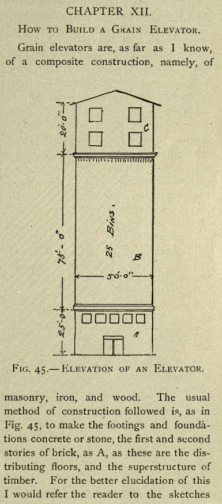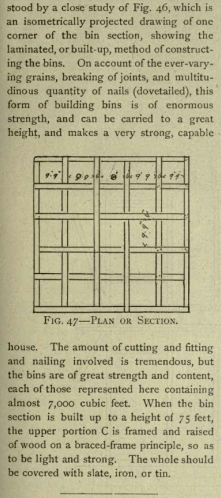Grain elevators were built one of two ways. 1. Log Cabin where 2X material was stacked and nailed flat starting with wide boards and slowly getting narrow as the wall went up. 2. was the standard stud construction with wall boards. Either way a lot of lumber was used. Siding would be as the photo in Spoor Vol. 3 page 24 Corrugated steel behind the train with a stud construction covered with outside reinforcing 4X4 or 6X6 with steel rods running across the bins Also note the round bins often used to store grain during and till the mid-60's in USDA bins. Now check out Spoor Vol. 2 page 49 the lower photo at Sugar Grove Green Shingle material on the walls. Sheridan had flat sheets of asbestos board. Also remember you can not see all four sides of a building at once so just model the side you can see. In some cases steel tanks were put up starting in the late teens to early 1920's often in combination with an older wood/tin covered see my article in Zephyr 62. Also note the difference in weathering on an elevator not maintained. Steve in SC
On Monday, April 15, 2019, 7:22:28 PM CDT, jack winegar <mrsafe@comcast.net> wrote:
Hello Louis. Based on my limited knowledge of how wood Grain Elevators were built 100 years ago; Not all Grain Elevators were sided with wood or corrugated metal. The picture you sent appears to me to be built with dimensioned lumber laid on its side as shown on Fig. 46 below. Jack Winegar www.VCLCo.com
  
On April 15, 2019 at 12:40 PM "Louis Zadnichek via Groups.Io" <LZadnichek=aol.com@groups.io> wrote:
April 15, 2019
Doug - I'm attaching a post card view of the Q's Rulo, NE, yards dated 1912. Although the image is very faded, it gives a good look at the massive timber framed grain elevator complete with box cars for grain loading. Can you tell if the elevator is wood planked or sheathed in corrugated iron (or both)? This had to be one of the larger grain elevators in rural Nebraska for its era. This view will soon be posted in the BRHS Member's Section historical CB&Q Flickr photograph archive. Also, note the combination way car/combine at center. Best Regards - Louis
Louis Zadnichek II Fairhope, AL
In a message dated 4/15/2019 8:52:21 AM Central Standard Time, doug.harding@iowacentralrr.org writes:
Thanks for the history. I was not aware that corrugated iron had been around that long. From: CBQ@groups.io [mailto:CBQ@groups.io] On Behalf Of Gerry Michael via Groups.Io
Sent: Monday, April 15, 2019 8:04 AM
To: CBQ@groups.io
Subject: Re: [CBQ] CB&Q Grain Elevators, Grain Covered Hoppers, and Traffic I did a little poking around on the Internet and found few items that might be of interest.
A short article on the "History of Corrugated Iron" at https://www.world-archaeology.com/features/history-of-corrugated-iron/
A few excerpts from the article:
"The story starts with Henry Palmer of the London Dock Company who, in 1829, took out a patent for ‘indented or corrugated metallic sheets’. "
" By the end of 1849, over 80,000 gold diggers and their hangers-on had arrived in California’s Sacremento Valley. San Francisco was ‘a bawdy, bustling, bedlam of mudholes and shanties’. Prefabricated wooden huts and tents sprouted but corrugated iron buildings were cheaper, fireproof and much more comfortable, according to Peter Naylor who shipped 500 of them from New York. British manufacturers were not slow off the mark. Edward T Bellhouse of Manchester sent houses of up to 12 rooms, complete with wallpaper and carpets. As the Californian market declined, the Australian gold rush kicked in."
The article is based on a book entitled Corrugated Iron: Building on the Frontier by Adam Mornement and Simon Holloway.
Another article at http://www.buffaloah.com/h/elev/hist/3/ has a section on the motivation for using corrugated iron siding for grain elevators: fireproofing and the relative costs of both the building materials and associated fire insurance. The article also notes that timber prices began to rise in the 1890s, which would also effect the relative costs of wood vs. corrugated iron.
Gerry Michael
On 4/15/2019 1:48 AM, Denny Anspach wrote: Some question has been raised about how early industrial corrugated iron siding, i.e. “wrinkle tin" came into use. The gargantuan former Sacramento SP Boiler Shop was constructed new with corrugated iron siding in 1887. This landmark building with its old siding intact (connected by working transfer table to the 26 bay Erecting Shop) is now a connected part of the California State Railroad Museum (as will be soon the Erecting Shop as well).
_._,_._,_
Groups.io Links:
You receive all messages sent to this group.
View/Reply Online (#57093) |
Reply To Group
|
Mute This Topic
| New Topic
Your Subscription |
Contact Group Owner |
Unsubscribe
[archives@nauer.org]
_._,_._,_
|


